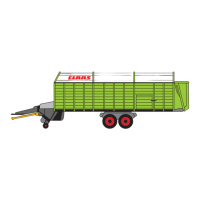TIC QUANTUM Hydraulics
10/04 11-9
When a control device is actuated, requiring an increased flow from the
pump, the pump pressure drops slightly.
The following condition results at the volume flow controller (8):
the pump pressure acts on the right-hand face end
the load pressure + the spring force of the compression spring act in the
spring space (Margin pressure) (21).
Since the load pressure + the spring force of the compression spring
(Margin pressure) (21) is higher than the pump pressure on the right face
end, the volume flow controller (8) is moved to the right up to the stop.
As a consequence:
the free circulation of the pump pressure to the control ram is blocked.
the control ram (14) is connected to the tank (no pressure on ram face).
the swash plate (17) is tilted aside by the control spring (15).
The pump now pumps a higher volume flow. This process is referred to as
“Upstroking”. The volume flow of the pump is determined by the restrictor
effect of the open spool cross-section or by the setting of the flow divider
of an additional control unit.
Reduced flow requirement
When the spool cross-section is reduced (the volume flow is to be
reduced), the load pressure at the input (7) drops. This changes the force
ratio at the volume flow controller (8), actuating the volume flow controller
to the left against the spring, according to the pressure drop. The control
ram (14) is pressurized and the swash plate (17) is set to a more
horizontal position - the pump performs a downstroke until the volume flow
requirement is met.

